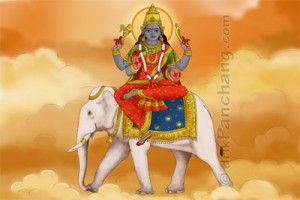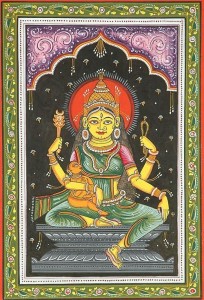इंद्राणी-ऐंद्री
इंद्राणी इंद्र-सद्द्रशी वज्र-शूला-गदा धरा
गजसंगत देवी लोचनिर्वसु भिवर्त ।।
(रूपमंडन)
इंद्राणी, महेन्द्री और वज्री के रूप में जानी जाने वाली ऐंद्री इंद्र की शक्ति है। उसका रंग गहरा लाल, दो आँखें और चार भुजाएँ हैं। जब उन्हे इंद्र की तरह हजार आँखों वाली चित्रित किया जाता हैं, तब उनका रंग सुनहरा और छह भुजाएँ मानी जाती हैं। वह नाना आभूषणों से अलंकृत, क्रीट मकुट धारण कर के, कल्प वृक्ष के नीचे बैठी हुई है। उनका वाहन हाथी है।
 चतृर्भुजी:
चतृर्भुजी:
देवी-पुराण और पुर्वकर्णगमा में उनकी चार भुजाओं का वर्णन किया गया हैं। अपने दो हाथों में वह वज्र और अंकुश धारण करती है जबकि अन्य दो हाथ वरद और अभय मुद्रा में हैं। कभी-कभी उन्हे अंकुश या कमल पकड़े हुए भी दिखाया जाता है।
षष्टभुजी:
विष्णुधर्मोत्तर के अनुसार, उसकी छह भुजाएँ हैं, चार हाथों में पाश, वज्र, कलश, अंकुश या कमल, अन्य दो हाथ अभय और वरद मुद्रा में हैं।
ॐ गजद् ध्वजाये विदमहे,
वज्र हस्ताय धीमहि।
तन्नौः ऐंद्राणी प्रचोदयात।।
 कल्पवृक्ष की प्रतीकात्मकता:
कल्पवृक्ष की प्रतीकात्मकता:
कल्पवृक्ष को कल्पतरु, कल्पद्रुम या कल्पपादप के नाम से भी जाना जाता है, यह एक इच्छा पूर्ण करने वाला दिव्य वृक्ष है। कल्पवृक्ष की उत्पत्ति कामधेनु के साथ “ समुंद्र मंथन” के दौरान हुई थी। देवताओं के राजा इंद्र इस पेड़ को अपने साथ स्वर्ग ले गये। कल्पवृक्ष की अनेक प्रजातियाँ हैं: जैसे पारिजात, बरगद, बबूल, शहतूत, महुआ, चूरी और शमी इत्यादि। ये पेड़ इंसान की सभी जरूरतों को पूरा करते हैं।
हाथी:
इस राजसी जीव को हजारों वर्षों से पौराणिक और धार्मिक कथाओं में चित्रित किया गया है। यह विशेष रूप से हिंदू और बौद्ध धर्म में महत्वपूर्ण हैं। हाथी की प्रतीकात्मकता के कई अर्थ और व्याख्याएं हैं:
- हाथी शक्ति, सद्भाव, शांत और धैर्य का प्रतीक है। वह संवेदनशीलता, ज्ञान, स्थिरता, निष्ठा, बुद्धिमत्ता, शांति, विश्वसनीयता और दृढ़ संकल्प का भी
 प्रतिनिधित्व करता है। यह शरीर और मन दोनों के लिये संदर्भित किया जाता है।
प्रतिनिधित्व करता है। यह शरीर और मन दोनों के लिये संदर्भित किया जाता है। - हाथी को हमारी आध्यात्मिक यात्रा में, आध्यात्मिक गुरू के रूप में भी देखा जाता है, जो हमें यात्रा में धैर्य रखना सिखाते है।
- गौतम बुद्ध की माँ, रानी माया गर्भवती नहीं हो रही थी। उन्होने एक सफेद हाथी को सपने में देखा, उसके बाद वह गर्भवती हुई और उन्होने बुद्ध को जन्म दिया।
- सफेद हाथियों को पवित्रता, दिव्यता और शांत मन का प्रतीक माना जाता है।
- धूसर(ग्रे) हाथी एक अप्रशिक्षित और उत्तेजित मन का प्रतीक है, जो आत्मज्ञान मार्ग से भटक गया है।
- ऐसा माना जाता है कि घर में और घर के आसपास हाथी के प्रतीक का उपयोग करने से नकारात्मकता दूर हो कर सौभाग्य आता है।
संदर्भ:
The Story Of Matrikas – Hindu Mythology
www.sanskritimagazine.com/indian-religions/hinduism/sapta-matrikas-the-seven-divine-mothers/
kaulapedia.com/en/ashta-matrika/
https://www.onetribeapparel.com/blogs/pai/elephant-symbols-meaning
www. templepurohit.com
Google Search
www. wikipedia.org
Photo: drik panchang.com
https://cdn-0.tailandfur.com/wp-content/uploads/2014/01/borom-com.jpg
AINDRI-INDRANI
Indrani Indra-sadrishi vajra-shlu-gada dhara ।
Gajasngata Devi lochanirvasu bhivrta ।।
(Rupamandana)
Aindri known as Indrani, Mahendri, Shakri and Vajri, is the shakthi of Indra. Her complexion is dark- red and has two eyes and four arms. When she depicted with thousand eyes like Indra then and her complexion is golden colour and has six arms. She is seated under the Kalpaka tree. She is richly ornamented; and adorned with Kirita Makuta. Her vahana is elephant.
 When she depicted as four hands:
When she depicted as four hands:
Devi-purana and Purvakaranagama depicted her with four arms. In two of her hands she carries the Vajra (thunderbolt) and the shakthi; while the other two gesture Varada and Abhaya mudra. Sometimes she is shown holding Ankusha (goad) and lotus.
When she depicted as six hands:
According to the Vishnudharmottara, She have six arms, four of the hands carrying the sutra, Vajra, Kalasa (a pot) and Patra (a drinking cup) and the remaining hands being held in Abhaya and Varada mudra.
Aum Gajath-vajaayai Vidmahe,
Vajra Hasthaya Dhimahee।
Thanno Indrani Prachodayath।।
 Symbolism of Kalpavriksha:
Symbolism of Kalpavriksha:
Kalpavriksha also known as kalpataru, kalpadruma or kalpapādapa, is a wish-fulfilling divine tree. The Kalpavriksha originated during the “Samudra Manthan of the ocean” along with the Kamdhenu. The king of the gods, Indra, returned with this tree to his paradise. Kalpavriksha is also identified with many trees such as parijata, baniyan, babool, Shahtoot, Mahua, Chiuri and Shami. These trees, fullfill all the needs of human being.
Elephant:
These majestic creatures have been depicted in mythology and religion for thousands of years. There are many meanings and interpretations behind elephant symbols, which are particularly significant in Hinduism and Buddhism.

- Elephant symbolizes strength, power, harmony, calm and patience. He also represents sensitivity, wisdom, stability, loyalty, intelligence, peace, reliability and determination.
- These meaning refers to both the body and the mind. The elephant is also seen as a sort of spiritual guide to help us along a journey that requires patience.
- Buddha’s mother, Queen Maya was not getting pregnant. She dreamt of a white elephant, after that she got pregnant and gave birth to Buddha.
- White elephants are believed to be a symbol of purity, divinity and a calm mind.
- Grey elephants symbolize an untrained and agitated mind, which tends to wander off from the path toward enlightenment.
- It is believed that using elephant symbolism in and around the household will bring good luck and it removes the negativity.
References:
https://www.onetribeapparel.com/blogs/pai/elephant-symbols-meaning
The Story Of Matrikas – Hindu Mythology
www.sanskritimagazine.com/indian-religions/hinduism/sapta-matrikas-the-seven-divine-mothers/
kaulapedia.com/en/ashta-matrika/
www. templepurohit.com
Google Search
Wikipedia.org
Photo: drik panchang.com
https://cdn-0.tailandfur.com/wp-content/uploads/2014/01/borom-com.jpg


